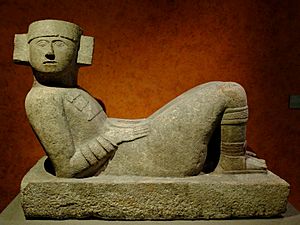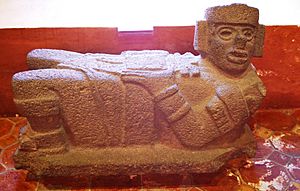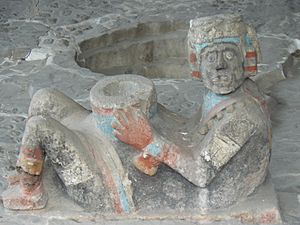Chacmool facts for kids

A chacmool (also spelled chac-mool) is a form of pre-Columbian Mesoamerican sculpture depicting a reclining figure with its head facing 90 degrees from the front, supporting itself on its elbows and supporting a bowl or a disk upon its stomach. These figures possibly symbolised slain warriors carrying offerings to the gods; the bowl upon the chest was used to hold sacrificial offerings, including pulque, tamales, tortillas, tobacco, turkeys, feathers and incense. In an Aztec example, the receptacle is a cuauhxicalli (a stone bowl to receive sacrificed human hearts). Chacmools were often associated with sacrificial stones or thrones.
Aztec chacmools bore water imagery and were associated with Tlaloc, the rain god. Their symbolism placed them on the frontier between the physical and supernatural realms, as intermediaries with the gods. The chacmool form of sculpture first appeared around the 9th century AD in the Valley of Mexico and the northern Yucatán Peninsula.
Contents
Form
The chacmool is a distinctive form of Mesoamerican sculpture representing a reclining figure with its head facing 90 degrees from the front, leaning on its elbows and supporting a bowl or a disk upon its chest. There is great variation among individual chacmools, with some possessing heads that are right-facing and others left-facing, and some with the heads facing upwards; some examples have movable heads. The figure may be lying on its back or on its side and the abdomen can be sunken below the level of the chest and knees or at the same level. Some chacmools were raised upon rectangular bases. Some of the figures are richly attired whilst others are almost naked.
The chacmools of Chichen Itza and Tula depict young men with warrior attributes, while the chacmools of Michoacán depict elderly men with wrinkled faces. A chacmool from Guácimo, Costa Rica, combines human and jaguar features and grips a bowl. The face of the figure looks upwards and the bowl was apparently used to grind foodstuffs.
A wide variety of materials were used to sculpt chacmools, including limestone and hard metamorphic and igneous rock types. Other materials employed include ceramic and cement.
Discovery and naming
The ancient name for these type of sculptures is unknown. The term chacmool is derived from the name “Chaacmol,” which Augustus Le Plongeon in 1875 gave to a sculpture that he and his wife Alice Dixon Le Plongeon excavated within the Temple of the Eagles and Jaguars at Chichén Itzá in 1875; he translated Chaacmol from Yucatecan Mayan as the “paw swift like thunder.” Le Plongeon believed the statue, which he had found buried beneath the Platform of the Eagles and the Jaguars, depicted a former ruler of Chichen Itza. Le Plongeon's sponsor, Stephen Salisbury of Worcester, Massachusetts, published Le Plongeon's find, but revised the spelling to "Chac-Mool."
Le Plongeon sought permission from Mexico's president to display the statue at the Centennial Exhibition in Philadelphia in 1876, a request that was denied. In 1877 the Yucatecan government seized the statue and brought it to Mérida. Weeks later Yucatán turned over the statue to the federal government, which brought it to Mexico City to the National Museum of Anthropology. Museum worker Jesús Sanchez realised that the Chichen Itza sculpture was stylistically similar to two sculptures from central Mexico and the wide occurrence of the form within Mesoamerica was first recognised. The 19th century discovery of chacmools in both central Mexico and the Yucatán Peninsula helped to promote the idea of a Toltec empire although the chacmool sculptures may have originated in the Maya region.
Although the name chacmool was inappropriately applied, it has become a useful label to link stylistically similar sculptures from different regions and periods without imposing a unified interpretation. Besides these sites, the sculpture was also found in Michoacán, where it is called Uaxanoti (The Seated One) in the Purépecha language.
Distribution

Examples of chacmool sculptures have been found widely across Mesoamerica from Michoacán in Mexico down to El Salvador. The earliest examples date from the Terminal Classic period of Mesoamerican chronology (c. AD 800–900). Examples are known from the Postclassic Aztec capital of Tenochtitlan, from the central Mexican city of Tula and from the Maya city of Chichen Itza in the Yucatán Peninsula. Fourteen chacmools are known from Chichen Itza and twelve from Tula. The chacmool from the palace at Tula is dated to the Early Postclassic (c. AD 900–1200). Further examples are known from Acolman, Cempoala, Michoacán, Querétaro and Tlaxcala.
In Chichen Itza, only five of the fourteen chacmools were securely confirmed in architectural contexts, those in the Castillo, the Chacmool Temple, the North Colonnade, the Temple of the Little Tables and the Temple of the Warriors. The rest were found interred in or near important structures. The five that were found in secure architectural contexts were all placed within entrance areas near a ritual seat or throne. The chacmools in Tula also had an association with thrones or raised seating platforms, either in front of the throne or at the entrance to a chamber containing a throne.
Two chacmools have been recovered that were associated with the Great Temple of Tenochtitlan, the Aztec capital. The first was discovered in 1943, on the junction of Venustiano Carranza and Pino Suarez, about two blocks south of the temple itself. The second chacmool was excavated in the sacred precinct. This is the only fully polychrome chacmool that has been recovered anywhere; it had an open mouth and exposed teeth and stood in front of the temple of Tlaloc, the Aztec rain god; its sculpted bowl probably received heart and blood sacrifices. This latter sculpture is by far the older of the two.
Chacmools have been reported as far south as the Maya city of Quiriguá, near the Guatemalan border with Honduras. The Quiriguá chacmool most likely dated to the Postclassic period and is stylistically similar to those of Tula rather than Chichen Itza. Two chacmools were reported from Tazumal, a Maya site in western El Salvador. A chacmool was excavated at Las Mercedes in Guácimo, Costa Rica.
Dating and origin

The oldest chacmool ever discovered was the Terminal Classic. The form was unknown in such important Mesoamerican cities as Teotihuacan and Tikal. After the first appearance of the form, it was rapidly disseminated throughout Mesoamerica, spreading as far south as Costa Rica. Although a central Mexican origin is generally assumed, there are no antecedents pre-dating the Toltecs and the form is not present in central Mexican codices.
The positioning and context of the chacmool form do have antecedents in Classic Maya art and art historian Mary Ellen Miller has argued that the chacmool developed out of Classic period Maya imagery. No central Mexican chacmool has been found that clearly predates the Chichen Itza examples. However, Tula and Chichen Itza may have developed simultaneously with rapid communication of the chacmool form from one city to the other.
The wider variety of chacmool forms at Chichen Itza has also been used to support the development of the form there; no two possess identical form, dress and proportions. At Tula the chacmools have a standardised form with little variation in position or proportions. Miller has proposed that the chacmool developed out of Classic Maya iconography and underwent a transition into three dimensional sculpture at Chichen Itza, perhaps spurred by the influence of central Mexican sculptural forms. A chacmool from Costa Rica was dated by the excavators to approximately AD 1000.
Aztec Chacmool
During the 1930 excavation of Templo Mayor, the only fully polychrome chacmool to be found at that site was in its original context on the top level of the Tlaloc side (the side dedicated to the rain god) of the temple. Because this chacmool statue sat in the same position as the sacrificial stone on the Huitzilopochtli side of the temple, "historical interpretations" are confirmed in the idea that this sculpture acted as a divine messenger, a link between the temple priest(s) and the god (in this case the rain god Tlaloc).
The pigment that remained upon this chacmool sculpture was crucial for the iconographic identification of the figure, as it does not contain any iconography or symbols associated with the rain god Tlaloc (the god with which this sculpture is associated at the Templo Mayor). Upon this Aztec sculptures discovery, a color reconstruction was created as a result of the work involving a series of steps: the production of a line drawing of the statue, a diligent cleaning of the colored surfaces of the statue, and the establishment of spatial recognition by means of the use of "stereoscopic magnifying glasses and ultraviolet light." Scholars determined that the Aztec chacmool discovered at the Templo Mayor did in fact contain representations of the rain god (Tlaloc) by recognizing similarities between "the circular gold pectoral medallion, the color combination on the petticoat . . . the black skin, the red hands and feet, and the white headdress and bangles," all of which suggest similar stylistic and iconographic progression among earlier and later Mexica chacmool sculptures.
A second chacmool discovery from the Templo Mayor and dating to a later period displays iconographic features which are distinct from the larger corpus of other figures but consistent with other sculptures found in the same context at the Templo Mayor. The other representations baring the distinct iconography include Tlaloc ritual vessels and bench reliefs. One of the distinct iconographic features is the representation of the eyes. Whereas Tlaloc's eyes are generally represented with a round goggle-like frame, the later chacmool, the vessels, and the bench relief feature a rectangular eye frame within which almond eyes are engraved. All three sculptures also include large fangs at the corners of the god's mouth. The ornaments worn by the later chacmool and depicted in the vessels and the bench relief of the Templo Mayor are also distinct rather than the characteristic earspools with a square plug and central dangal. These examples sport oversized circular spools. All three examples are also adorned with a multistrand, beaded collar in which one strand has larger beads that have been interpreted as hanging bells. The chacmool holds onto a cuauhxicalli vessel that also is engraved with the face of the god with the same rectangular eye and mouth features.
In contemporary culture
The short story "Chac Mool" by Mexican novelist Carlos Fuentes is found in his book Los días enmascarados (The masked days), published in 1954. A man named Filiberto buys a chacmool for his art collection, and discovers that the stone is slowly becoming flesh. The idol eventually becomes fully human, dominating his life, causing flooding and other disasters. Filiberto dies by drowning. His story is found in a diary describing the terrors brought on by the idol, and his plans to escape. According to the author, this short story was inspired by news reports from 1952 when the lending of a representation of the Maya rain deity to a Mexican exhibition in Europe had coincided with wet weather there.
In Henry Moore's early examples of monumental reclining figures, the artist relied on the cast of a chacmool sculpture he saw in Paris. Commenting on the major impact chacmool sculpted figures had on his early career, Moore stated that "Its stillness and alertness, a sense of readiness - and the whole presence of it, and the legs coming down like columns" were characteristics that inspired his creations.
See also
 In Spanish: Chac mool para niños
In Spanish: Chac mool para niños

